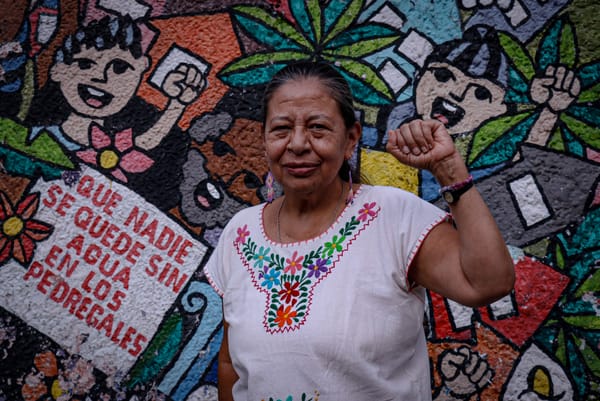Faces of Water: Where a river is born
Among the many women who defend water in Latin America are the residents of the Pedregal of Santo Domingo in southern Mexico City.

The residents of the Pedregal of Santo Domingo, a neighborhood of a hundred thousand residents in the south of Mexico City, have long had to fight for potable water. When, in early 2015, they discovered that a construction site in the area was channeling a freshwater spring into the sewer, they installed a protest camp in the street. It lasted more than two years, and the neighbors became pioneers in the fight for their right to potable water in the Mexican capital.
Since Santo Domingo was founded in the early 1970s, women supplied their homes with water from public taps and wells. To carry it, they used an aguantador, a yoke with a bucket on either side, which became a symbol of local identity. When you occupy a piece of land and build a neighborhood along with your neighbors, water access becomes a shared problem most easily resolved in community. Half a century later, they became defenders of drinking water against the avarice of real estate.
María de los Ángeles Fernández, known as Doña Fili, is a referent in the history of the capital’s housing rights movements, and she frequently retells the story of Santo Domingo’s founding to young visitors she meets at protests and meetings.
When Doña Fili welcomes a guest into her home, she has the custom of giving them a stone from her altar. The assortment of volcanic rocks shares space with images of social activists from across the continent: Emiliano Zapata, Monseñor Romero and Victor Jara, the journalist Javier Valdéz and the Nahua land defender Samir Flores, all illuminated by a candle’s constant flame.
Sometimes Fili, a tiny women with deep wrinkles and smiling eyes, wraps the stones in the red kerchief typical of farm workers, also an icon that represents the Zapatista indigenous struggle. The stones have witnessed the creation of the neighborhood, the Pedregal of Santo Domingo, whose founding in 1971 gave it the title of the largest urban land occupation in Latin America.
“The houses were so alike that you could go into another one as if it were your own,” Fili recalls. “We would say, may all of us have homes, even if they’re made out of metal sheets, it doesn’t matter. May all of us have a home.”
In this area of stony, hostile soil, part of the Coyoacán delegations, the neighbors organized to buy dynamite and open the streets. The men worked in factories and the women cleaned homes in wealthy neighborhoods. On the weekends, everyone came together to build.
“It was quite beautiful, because we shared the work. Your hands ended up bloody from carrying dirt and rocks, and the next day you had to work,” Fili remembers. “It was really hard, but because you knew it was for you, it didn’t tire you out, even though there wasn’t electricity or water. We didn’t have anything! The government wasn’t here, except to try to throw us out. But if you didn’t have water, a boy brought you a full bucket and then you had water. The people helped you out.”
With time and collective work, the neighbors exchanged their metal walls for cement. In 1997, the first leftist mayor of the capital, Cuauhtémoc Cárdenas, gave the inhabitants of Santo Domingo the titles to their houses. After nearly three decades, the neighbors forced the state to recognize their legitimacy and that of the homes they built, now connected to the city’s public water system.
Text: Flor Pagola, Caro Bas, Madeleine Wattenbarger and Eliana Gilet
Photo: Lizbeth Hernández
Design: Paola Macedo
This story is part of Faces of Water: Stories of Women Defending Water in Montevideo and Mexico City, a project by the Cooperativa de Periodismo and Kaja Negra, supported by the 2024 ColaborAccíon grant from the Fundación Gabo and Fundación Avina.



